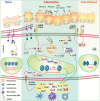Eavesdropping on the conversation between immune cells and the skin epithelium
- PMID: 30721971
- PMCID: PMC6626297
- DOI: 10.1093/intimm/dxy088
Eavesdropping on the conversation between immune cells and the skin epithelium
Abstract
The skin epithelium covers our body and serves as a vital interface with the external environment. Here, we review the context-specific interactions between immune cells and the epithelium that underlie barrier fitness and function. We highlight the mechanisms by which these two systems engage each other and how immune-epithelial interactions are tuned by microbial and inflammatory stimuli. Epithelial homeostasis relies on a delicate balance of immune surveillance and tolerance, breakdown of which results in disease. In addition to their canonical immune functions, resident and recruited immune cells also supply the epithelium with instructive signals to promote repair. Decoding the dialogue between immunity and the epithelium therefore has great potential for boosting barrier function or mitigating inflammatory epithelial diseases.
Keywords: DETCs; Langerhans cells; epithelial immunity; regeneration and repair; regulatory T cells.
© The Japanese Society for Immunology. 2019. All rights reserved. For permissions, please e-mail: journals.permissions@oup.com.
Figures


References
-
- Mueller S. N. and Mackay L. K. 2016. Tissue-resident memory T cells: local specialists in immune defence. Nat. Rev. Immunol. 16:79. - PubMed
-
- Pasparakis M.,Haase I. and Nestle F. O. 2014. Mechanisms regulating skin immunity and inflammation. Nat. Rev. Immunol. 14:289. - PubMed
-
- Lowes M. A.,Bowcock A. M. and Krueger J. G. 2007. Pathogenesis and therapy of psoriasis. Nature 445:866. - PubMed

